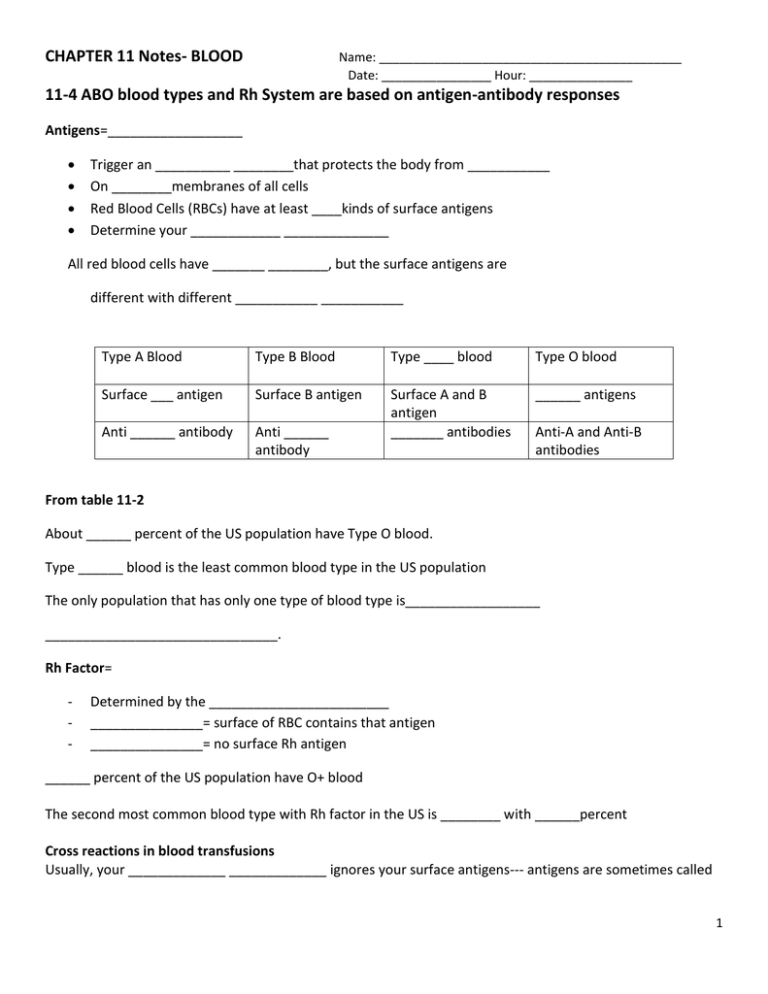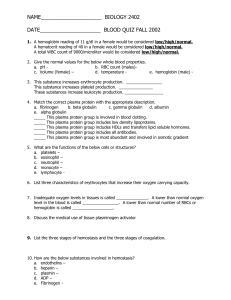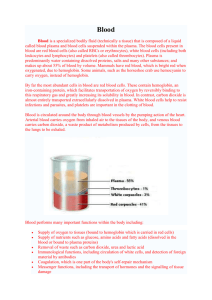11-4 ABO blood types and Rh System are based on antigen
advertisement

CHAPTER 11 Notes- BLOOD Name: ____________________________________________ Date: ________________ Hour: _______________ 11-4 ABO blood types and Rh System are based on antigen-antibody responses Antigens=__________________ Trigger an __________ ________that protects the body from ___________ On ________membranes of all cells Red Blood Cells (RBCs) have at least ____kinds of surface antigens Determine your ____________ ______________ All red blood cells have _______ ________, but the surface antigens are different with different ___________ ___________ Type A Blood Type B Blood Type ____ blood Type O blood Surface ___ antigen Surface B antigen ______ antigens Anti ______ antibody Anti ______ antibody Surface A and B antigen _______ antibodies Anti-A and Anti-B antibodies From table 11-2 About ______ percent of the US population have Type O blood. Type ______ blood is the least common blood type in the US population The only population that has only one type of blood type is__________________ _______________________________. Rh Factor= - Determined by the ________________________ _______________= surface of RBC contains that antigen _______________= no surface Rh antigen ______ percent of the US population have O+ blood The second most common blood type with Rh factor in the US is ________ with ______percent Cross reactions in blood transfusions Usually, your _____________ _____________ ignores your surface antigens--- antigens are sometimes called 1 CHAPTER 11 Notes- BLOOD Name: ____________________________________________ Date: ________________ Hour: _______________ ____________________________ Antibodies= - However, your _____________contains antibodies (also called _____________________) that attack surface antigens of RBCs that are of a different _____________________ _______________________. - If you receive a different blood type, _______________in your plasma meet their specific antigen on the donated RBCs - This binding causes ______________ of the RBCs - This is called _____________________________ - This clumping can plug small ___________________ in the kidneys, lungs, heart, or blood, damaging or destroying _______________ - This all can be avoided by making sure the donor and recipient are ______________________. - Draw a diagram of which blood types can receive what blood: Rh and blood transfusions - Plasma of a person with _____ __________________ blood does not usually contain any ______ _______________ These antibodies are only present in your blood if you have been previously ___________ to Rh antibodies Exposure can occur through a __________________ or during a _______________________ Erythroblastosis fetalis/Hemolytic disease of the newborn= 2 CHAPTER 11 Notes- BLOOD Name: ____________________________________________ Date: ________________ Hour: _______________ 11-1 Functions and Characteristics of Blood The cardiovascular system ____________ all other body systems Kind of like a cooling system of a car both have ______________ _______________ (blood v. water) both have a ____________________ (heart v. water pump) both use __________________ _____________ to carry the fluid (blood vessels v. radiator hoses) both can _______________ from fluid loss, pump failure, or damaged tubing First body system to be formed in the ________________ _____________________ used first Heart begins beating in the ___________ week of pregnancy Embryo can now use _______________ from the blood stream more ______________ Embryo _______________in size the next week Functions of the blood: 1. Transportation Dissolved ___________, ____________, _______________, and _____________ ________________ Carries ____________ to the ______________ Carries _______________ _____________________from the tissues to the lungs Distributes nutrients that are either______________ at the ________________ __________ or released from storage in ________ or ___________ 3 CHAPTER 11 Notes- BLOOD Name: ____________________________________________ Date: ________________ Hour: _______________ Carries _______________ from endocrine glands Absorbs _____________ and transports them to the _________________ for excretion 2. Regulation Regulates_______ and composition of ions throughout the body Absorbs and ____________acids made by tissues. Example: ____________ _________ produced by muscles when working out Prevents too much ______________ or _____________ ___________ 3. Prevents fluid loss Blood contains _______________ and other components that ____________ blood loss Clotting form a _______________ ______________ that prevents further ____________ of blood volume 4. Defense Blood transports ____________ _____________ _____________ (________) around the body which fight______________ and remove__________ and other _____________ Delivers _____________ which attach invading ___________ and other alien compounds 5. Regulation of body temperature Blood ___________ ____________ made by muscles and redistributes it to ____________ _____________ When your body temperature is_______, blood is directed to the ______________________________________________________ When your body temp is too _________, the flow of blood is restricted to _________________ _____________________________________________________________________________ Blood Composition: Blood is basically ___________________ ______________________ _______________________ Made up of a ____________ of plasma and _________________ _____________________ Plasma is made up of _____________________ ______________________, not insoluble fibers like those in ___________________________________________________________ Plasma is __________________ ________________________ than water 4 CHAPTER 11 Notes- BLOOD Name: ____________________________________________ Date: ________________ Hour: _______________ Formed elements are _____________ _______________ and cell fragments (platelets) which are suspended in the plasma These include: Red blood cells or ______________________ White blood cells or _______________________ ____________________________ __________________________________= Process that produced formed elements - Made by _________________________________________________________________________ Together, the ___________________and ________________ ______________ make up the ________________ ________________ On average, a _____________ has about ________________________________ of whole blood A _________________has about _______________________________ of whole blood All of the ______________________________ of the whole blood can be ___________________ (or separated) for analytical or clinical purposes Blood Collection Venipuncture - Fresh whole blood is collected from the anterior ___________________________________________ __________________________________________________________________________________ Common sampling technique because superficial veins are _______________________________ and have thinner wall than _____________________ Also, ___________________ ___________________ in the venous system is relatively low so the puncture seals quickly Arterial Puncture - Drawing blood from an ________________ - May be needed for __________________________________________________________________ ___________________________________________________________________________________ 5 CHAPTER 11 Notes- BLOOD - Name: ____________________________________________ Date: ________________ Hour: _______________ Samples are usually drawn from the ______________ ______________ at the wrist or brachial artery at the elbow Whether or not whole blood is drawn from an artery or vein, it still has these same basic characteristics: o ______________________________: 100.4 degrees F (just above normal body temp) o Viscosity: blood is ______________________________________________________________ o pH: blood is slightly basic- average ph= __________ 11-2 Plasma Plasma makes up about _________________ of the volume of ______________________________ Water makes up about ______________ of the volume of plasma Plasma contains lots of ___________________ ________________________ These _________________ are too large to diffuse through the walls of the capillaries, so they ____________ ____________________________________________________________________________ Plasma is made up of: - 1. ______________________: (60%) o Most abundant proteins o Contribute to _______________________________________________________________ - 2. ______________________: (35%) o Include _________________________________________________________________ Antibodies are also called ___________________________ and attack foreign proteins and pathogens Transport proteins bind to small ions, hormones, or other compounds ______________ ________________________________________________________________________ ________________________________________________________________________ 6 CHAPTER 11 Notes- BLOOD Name: ____________________________________________ Date: ________________ Hour: _______________ Plasma and fat transport: - Albumins and globulins bind to __________________________________________________________ _______________________________________________________________________ - However, when the plasma proteins bind to the lipid, they make a compound that is _______________ ________________________________________________________ - This compound allows for lipids to be _____________________________________________________ - This compounds are called ______________________ 3. The third and last type of plasma protein is_________________________ o Used in ___________________________________________________ o Interact to make fibrin; __________________________________________________________ __________________________________________________ o _________________is the fluid left over after the _____________________________________ _____________________________________________________________________________ The liver makes about ___________________________________________________________________ Antibodies are made by the ______________________________________________________ _______________________________________________________ Liver disorders can alter the ___________________________________________________________________ _________________________________________________________________________________________ Example: __________________________________________________________________________________ __________________________________________________________________________________________ 7






